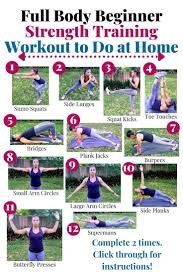Introduction
Starting a fitness journey from home, especially without equipment, can be daunting. However, with the right plan, you can build strength, improve endurance, and lose weight—all without needing to buy expensive gear or go to a gym. This beginner’s fitness plan is designed to help you get started, offering easy-to-follow exercises that will challenge you while keeping things simple and effective.
1. Why Choose a Home Workout?
Exercising at home has become increasingly popular due to its convenience and affordability. You don’t have to worry about gym memberships, commuting, or feeling self-conscious. Plus, home workouts give you the flexibility to exercise on your schedule and in the comfort of your own space.
Key Benefits of Home Workouts:
-
Convenience: Work out whenever you have time, without the need to leave your house.
-
Cost-effective: No need to spend money on a gym membership or expensive equipment.
-
Privacy: Feel more comfortable trying new exercises or building your routine without others around.
2. Setting Realistic Goals
Before diving into any fitness routine, it’s important to set clear and achievable goals. Whether your goal is to improve general fitness, lose weight, or increase flexibility, knowing what you want to achieve will guide your workout choices and motivate you to stay consistent.
Example Goals for Beginners:
-
Complete a 20-minute workout 3 times a week.
-
Increase endurance by walking or jogging 1 mile without stopping.
-
Perform 10 push-ups in a row within 30 days.
3. Essential Beginner Exercises
For a well-rounded fitness plan, it’s important to target all major muscle groups. The following exercises can be done at home with no equipment and will help you build strength, flexibility, and endurance.
1. Bodyweight Squats
Squats are a great way to strengthen your lower body, targeting your quads, hamstrings, and glutes.
-
How to Perform: Stand with your feet shoulder-width apart, keeping your back straight. Bend your knees and lower your hips as if you’re sitting in a chair. Push through your heels to stand back up.
2. Push-ups
Push-ups are an excellent upper body exercise, working your chest, shoulders, and triceps.
-
How to Perform: Start in a plank position with your hands slightly wider than shoulder-width apart. Lower your body toward the ground, keeping your body in a straight line. Push back up to the starting position.
3. Planks
Planks help build core strength, which is essential for maintaining good posture and preventing injuries.
-
How to Perform: Lie face down and raise yourself on your forearms and toes. Keep your body in a straight line from head to heels. Hold for 20-30 seconds to start, gradually increasing as you get stronger.
4. Glute Bridges
Glute bridges strengthen your glutes, lower back, and hamstrings.
-
How to Perform: Lie on your back with your knees bent and feet flat on the floor. Lift your hips toward the ceiling, squeezing your glutes at the top, and lower back down.
5. Bicycle Crunches
Bicycle crunches are a dynamic exercise that targets the core, especially the obliques.
-
How to Perform: Lie on your back and bring your knees toward your chest. Alternate extending each leg while twisting your torso to bring your opposite elbow toward the knee.
4. Beginner’s Workout Plan (No Equipment)
This simple, beginner-friendly workout plan will help you get fit from home without any equipment. Aim to do this workout 3-4 times a week, with at least one rest day between sessions.
Warm-Up (5 Minutes)
Start by warming up to prevent injury and get your body ready for exercise:
-
Jumping jacks – 1 minute
-
High knees – 1 minute
-
Arm circles – 1 minute
-
Leg swings – 1 minute
-
Light jogging or marching in place – 1 minute
Workout Routine
-
Bodyweight Squats – 3 sets of 10-12 reps
-
Push-ups – 3 sets of 8-10 reps
-
Planks – 3 sets of 20-30 seconds
-
Glute Bridges – 3 sets of 12-15 reps
-
Bicycle Crunches – 3 sets of 12-15 reps per side
Cool Down (5 Minutes)
Finish your workout with some gentle stretching to improve flexibility and promote recovery:
-
Standing hamstring stretch – 1 minute per side
-
Cat-Cow stretch (on all fours) – 1 minute
-
Child’s pose – 1 minute
-
Arm and shoulder stretches – 1 minute
5. Tips for Success
Staying consistent and focused is key to achieving your fitness goals. Here are some tips to help you stay on track:
-
Start Slow: If you’re new to exercising, don’t overdo it. Gradually increase the intensity and duration as you become more comfortable.
-
Stay Consistent: Consistency is key to seeing results. Aim to work out at least 3 times a week to build a routine.
-
Listen to Your Body: If you feel pain (not to be confused with muscle fatigue), stop the exercise and rest. Don’t push through discomfort.
-
Track Progress: Keep a log of your workouts and track improvements in strength and endurance over time.
6. Common Mistakes to Avoid
Many beginners make mistakes when starting a home fitness plan. Here are a few to avoid:
-
Skipping Warm-ups: Warm-ups are crucial for preparing your muscles and joints for exercise. Never skip them.
-
Poor Form: Using improper form can lead to injuries. Always focus on technique, even if it means doing fewer reps.
-
Overtraining: Working out too frequently or with too much intensity can lead to burnout and injury. Give your body time to recover.
7. Staying Motivated
One of the biggest challenges in any fitness journey is staying motivated. Here are some tips to keep yourself engaged and excited about your workouts:
-
Set Milestones: Celebrate small wins along the way, such as increasing your reps or holding a plank longer.
-
Mix Things Up: Keep your workouts fresh by changing the exercises or trying new routines.
-
Join a Community: Find a fitness community online or with friends to stay accountable and share your progress.
Conclusion
Starting a fitness plan at home without equipment is not only effective but also affordable and flexible. By sticking to a well-rounded workout routine and staying consistent, you can build strength, improve flexibility, and reach your fitness goals—without stepping foot in a gym. Keep your workouts varied, track your progress, and enjoy the journey to a healthier, fitter you.



